Warmforming Flow Pressing Characteristics of Continuous Fibre Reinforced Thermoplastic Composites
Abstract
:1. Introduction
2. Clinching of Fibre-Reinforced Plastics
3. Materials and Methods
3.1. Material Specification
3.2. Experimental Setup and Characteristic Dimensions
3.2.1. Flat Crush Test with Elevated Temperatures
3.2.2. Tribological Analysis with Modified Pin-on-Disk Test
3.3. Friction Compensation
3.4. Evaluation Methods
4. Results
4.1. Initial Material Structure
4.2. Compaction
4.3. Elastic-Plastic Material Behaviour of GF/PA6 under Pressure at 160 °C
4.4. Elastic-Plastic Material Behaviour of GF/PA6 under Pressure at 180 °C
4.4.1. Standard 2 mm—Configuration
4.4.2. 1 mm—Configuration
4.4.3. 4 mm—Configuration
4.5. Elastic-Plastic Material Behaviour of GF/PA6 under Pressure at 200 °C
5. Discussion
6. Summary
Author Contributions
Funding
Data Availability Statement
Conflicts of Interest
Abbreviations
| 2D | 2-dimensional |
| 3D | 3-dimensional |
| FC | friction coefficient |
| FVC | fibre volume content |
| GF | glass fibre |
| CF | carbon fibre |
| GFRP | glass-fibre-reinforced |
| CFRP | carbon-fibre-reinforced |
| PA6 | polyamide 6 |
| PEEK | polyetheretherketone |
| PEKK | polyetherketoneketone |
| PPS | polyphenylensulfide |
| PP | Polypropylene |
| TPC | thermoplastic composites |
| UD | unidirectional |
Appendix A. Specification of the Specimens
| Specimen Name | Initial Thickness in mm | Compaction Level in % | Temperature T in °C |
|---|---|---|---|
| A03_F_004 | 2.11 | 10 | 160 |
| A03_F_006 | 2.11 | ||
| A03_F_026 | 2.27 | 75 | 160 |
| A03_F_027 | 2.05 | ||
| A03_F_028 | 2.09 | ||
| A03_F_029 | 4.22 | 10 | 160 |
| A03_F_030 | 4.21 | ||
| A03_F_031 | 4.18 | ||
| A03_F_035 | 4.18 | 75 | 160 |
| A03_F_036 | 4.22 | ||
| A03_F_037 | 4.19 | ||
| A03_F_040 | 2.21 | 10 | 180 |
| A03_F_041 | 2.18 | ||
| A03_F_042 | 2.12 | ||
| A03_F_052 | 2.07 | 75 | 180 |
| A03_F_053 | 2.06 | ||
| A03_F_054 | 2.03 | ||
| A03_F_058 | 4.32 | 10 | 180 |
| A03_F_059 | 4.20 | ||
| A03_F_060 | 4.19 | ||
| A03_F_061 | 4.23 | ||
| A03_F_065 | 4.19 | 75 | 180 |
| A03_F_066 | 4.24 | ||
| A03_F_067 | 4.19 | ||
| A03_F_068 | 1.06 | 10 | 180 |
| A03_F_069 | 1.06 | ||
| A03_F_070 | 1.05 | ||
| A03_F_074 | 1.05 | 75 | 180 |
| A03_F_075 | 1.05 | ||
| A03_F_076 | 1.06 | ||
| A03_F_077 | 2.21 | 10 | 200 |
| A03_F_078 | 2.01 | ||
| A03_F_079 | 2.04 | ||
| A03_F_089 | 2.14 | 75 | 200 |
| A03_F_090 | 2.34 | ||
| A03_F_091 | 2.06 | ||
| A03_F_095 | 4.19 | 10 | 200 |
| A03_F_096 | 4.11 | ||
| A03_F_097 | 4.10 | ||
| A03_F_101 | 4.09 | 75 | 200 |
| A03_F_102 | 4.08 | ||
| A03_F_103 | 4.21 | ||
| A03_F_104 | 4.17 | 200 kN | 200 |
| A03_F_105 | 4.17 | ||
| A03_F_106 | 4.20 |
References
- Hollaway, L. A review of the present and future utilisation of FRP composites in the civil infrastructure with reference to their important in-service properties. Constr. Build. Mater. 2010, 24, 2419–2445. [Google Scholar] [CrossRef]
- Galińska, A.; Galinski, C. Mechanical Joining of Fibre Reinforced Polymer Composites to Metals—A Review. Part II: Riveting, Clinching, Non-Adhesive Form-Locked Joints, Pin and Loop Joining. Polymers 2020, 12, 1681. [Google Scholar] [CrossRef]
- Gröger, B.; Troschitz, J.; Vorderbrüggen, J.; Vogel, C.; Kupfer, R.; Meschut, G.; Gude, M. Clinching of Thermoplastic Composites and Metals—A Comparison of Three Novel Joining Technologies. Materials 2021, 14, 2286. [Google Scholar] [CrossRef]
- Lambiase, F.; Scipioni, S.I.; Lee, C.J.; Ko, D.C.; Liu, F. A State-of-the-Art Review on Advanced Joining Processes for Metal-Composite and Metal-Polymer Hybrid Structures. Materials 2021, 14, 1890. [Google Scholar] [CrossRef]
- Rotheiser, J. Joining of Plastics: Handbook for Designers and Engineers, 3rd ed.; Carl Hanser Verlag GmbH Co. KG: Munich, Germany, 2009. [Google Scholar]
- Eshtayeh, M.M.; Hrairi, M.; Mohiuddin, A.K.M. Clinching process for joining dissimilar materials: State of the art. Int. J. Adv. Manuf. Technol. 2015, 82, 179–195. [Google Scholar] [CrossRef]
- Kaščák, L.; Spišák, E.; Majerníková, J. Clinching and Clinch-Riveting as a Green Alternative to Resistance Spot Welding. In Proceedings of the 2019 International Council on Technologies of Environmental Protection (ICTEP), Starý Smokovec, Slovakia, 23–25 October 2019; pp. 138–142. [Google Scholar]
- Mucha, J. Clinching technology in the automotive industry. Arch. Automot. Eng. Archiwum Motoryz. 2017, 76, 75–94. [Google Scholar] [CrossRef]
- Lambiase, F.; Ilio, A.D.; Paoletti, A. Joining aluminium alloys with reduced ductility by mechanical clinching. Int. J. Adv. Manuf. Technol. 2014, 77, 1295–1304. [Google Scholar] [CrossRef]
- Israel, M.; Mauermann, R.; Schellnock, J. Thick sheet clinching–joining up to 20 mm total thickness. Adv. Shipp. Ocean. Eng. 2013, 2, 1–10. [Google Scholar]
- Lambiase, F.; Durante, M.; Ilio, A.D. Fast joining of aluminum sheets with Glass Fiber Reinforced Polymer (GFRP) by mechanical clinching. J. Mater. Process. Technol. 2016, 236, 241–251. [Google Scholar] [CrossRef]
- Lambiase, F.; Ko, D.C. Feasibility of mechanical clinching for joining aluminum AA6082-T6 and Carbon Fiber Reinforced Polymer sheets. Mater. Des. 2016, 107, 341–352. [Google Scholar] [CrossRef]
- Lambiase, F.; Paoletti, A. Friction-assisted clinching of Aluminum and CFRP sheets. J. Manuf. Process. 2018, 31, 812–822. [Google Scholar] [CrossRef]
- Lee, C.J.; Lee, S.H.; Lee, J.M.; Kim, B.H.; Kim, B.M.; Ko, D.C. Design of hole-clinching process for joining CFRP and aluminum alloy sheet. Int. J. Precis. Eng. Manuf. 2014, 15, 1151–1157. [Google Scholar] [CrossRef]
- Gude, M.; Vogel, C.; Gröger, B. Simulation-aided development of a robust thermoclinching joining process for hybrid structures with textile reinforced thermoplastic composites and metallic components. Mater. Werkst. 2019, 50, 1027–1038. [Google Scholar] [CrossRef]
- Seidlitz, H.; Gerstenberger, C.; Osiecki, T.; Simon, S.; Kroll, L. High-performance lightweight structures with Fiber Reinforced Thermoplastics and Structured Metal Thin Sheets. J. Mater. Sci. Res. 2014, 4. [Google Scholar] [CrossRef] [Green Version]
- Lin, P.C.; Lin, J.W.; Li, G.X. Clinching process for aluminum alloy and carbon fiber-reinforced thermoplastic sheets. Int. J. Adv. Manuf. Technol. 2018, 97, 529–541. [Google Scholar] [CrossRef]
- Vorderbrüggen, J.; Gröger, B.; Kupfer, R.; Hoog, A.; Gude, M.; Meschut, G. Phenomena of forming and failure in joining hybrid structures—Experimental and numerical studies of clinching thermoplastic composites and metal. In Proceedings of the 22nd International Esaform Conference On Material Forming: ESAFORM 2019, Vitoria-Gasteiz, Spain, 8–10 May 2019. [Google Scholar] [CrossRef]
- Gröger, B.; Köhler, D.; Vorderbrüggen, J.; Troschitz, J.; Kupfer, R.; Meschut, G.; Gude, M. Computed tomography investigation of the material structure in clinch joints in aluminium fibre-reinforced thermoplastic sheets. Prod. Eng. 2021, 16, 203–212. [Google Scholar] [CrossRef]
- Barnes, J.; Cogswell, F. Transverse flow processes in continuous fibre-reinforced thermoplastic composites. Composites 1989, 20, 38–42. [Google Scholar] [CrossRef]
- Adams, M.; Edmondson, B.; Caughey, D.; Yahya, R. An experimental and theoretical study of the squeeze-film deformation and flow of elastoplastic fluids. J. Non-Newton. Fluid Mech. 1994, 51, 61–78. [Google Scholar] [CrossRef]
- Silva-Nieto, R.J.; Fisher, B.C.; Birley, A.W. Rheological characterization of unsaturated polyester resin sheet molding compound. Polym. Eng. Sci. 1981, 21, 499–506. [Google Scholar] [CrossRef]
- Engmann, J.; Servais, C.; Burbidge, A.S. Squeeze flow theory and applications to rheometry: A review. J. Non-Newton. Fluid Mech. 2005, 132, 1–27. [Google Scholar] [CrossRef]
- Potluri, P.; Sagar, T. Compaction modelling of textile preforms for composite structures. Compos. Struct. 2008, 86, 177–185. [Google Scholar] [CrossRef]
- Ward, I.M.; Hine, P.J. Novel composites by hot compaction of fibers. Polym. Eng. Sci. 1997, 37, 1809–1814. [Google Scholar] [CrossRef]
- Coleman, C. On the squeezing flow of a fibre-reinforced fluid. J. Non-Newton. Fluid Mech. 1990, 37, 379–385. [Google Scholar] [CrossRef]
- Levy, A.; Martel, G.P.; Hubert, P. Modeling the Squeeze Flow of a Thermoplastic Composite Tape During Forming. In Proceedings of the 2012 COMSOL Conference, Boston, MA, USA, 3–5 October 2012. [Google Scholar]
- Picher-Martel, G.P.; Levy, A.; Hubert, P. Compression moulding of Carbon/PEEK Randomly-Oriented Strands composites: A 2D Finite Element model to predict the squeeze flow behaviour. Compos. Part A Appl. Sci. Manuf. 2016, 81, 69–77. [Google Scholar] [CrossRef]
- Sommer, D.E.; Kravchenko, S.G.; Pipes, R.B. A numerical study of the meso-structure variability in the compaction process of prepreg platelet molded composites. Compos. Part A Appl. Sci. Manuf. 2020, 138, 106010. [Google Scholar] [CrossRef]
- Valverde, M.A.; Belnoue, J.P.H.; Kupfer, R.; Kawashita, L.F.; Gude, M.; Hallett, S.R. Compaction behaviour of continuous fibre-reinforced thermoplastic composites under rapid processing conditions. Compos. Part A Appl. Sci. Manuf. 2021, 149, 106549. [Google Scholar] [CrossRef]
- Ghnatios, C.; Chinesta, F.; Binetruy, C. 3D Modeling of squeeze flows occurring in composite laminates. Int. J. Mater. Form. 2013, 8, 73–83. [Google Scholar] [CrossRef]
- Boisse, P. (Ed.) Advances in Composites Manufacturing and Process Design; Woodhead Publishing: Cambridge, UK, 2015. [Google Scholar]
- ten Thije, R.H.W.; Akkerman, R.; van der Meer, L.; Ubbink, M.P. Tool-ply friction in thermoplastic composite forming. Int. J. Mater. Form. 2008, 1, 953–956. [Google Scholar] [CrossRef]
- Murtagh, A.M.; Lennon, J.J.; Mallon, P.J. Surface friction effects related to pressforming of continuous fibre thermoplastic composites. Compos. Manuf. 1995, 6, 169–175. [Google Scholar] [CrossRef]
- ten Thije, R.; Akkerman, R.; Ubbink, M.; van der Meer, L. A lubrication approach to friction in thermoplastic composites forming processes. Compos. Part A Appl. Sci. Manuf. 2011, 42, 950–960. [Google Scholar] [CrossRef]
- Schlarb, A.K.; Ecke, N.; Kamerling, S.; Zhao, Y.; Lin, L. Performance and mechanisms of different tribological thermoplastic composites in sliding contact with steel. J. Thermoplast. Compos. Mater. 2021. [Google Scholar] [CrossRef]
- Lin, H.; Harrison, P.; van de Haar, K.; Long, A.; Akkerman, R.; Clifford, M. Investigation of tool-py friction of viscous textile composites (CD-rom). In Proceedings of the 8th International Conference on Textile Composites, TEXCOMP-8, Nottingham, UK, 16–18 October 2006. [Google Scholar]
- Böhnke, M.; Rossel, M.; Bielak, C.R.; Bobbert, M.; Meschut, G. Concept development of a method for identifying friction coefficients for the numerical simulation of clinching processes. Int. J. Adv. Manuf. Technol. 2021, 118, 1627–1639. [Google Scholar] [CrossRef]
- Brown, N.; Worrall, C.; Ogin, S.; Smith, P. Investigation into the mechanical properties of thermoplastic composites containing holes machined by a thermally-assisted piercing (TAP) process. Adv. Manuf. Polym. Compos. Sci. 2015, 1, 199–209. [Google Scholar] [CrossRef] [Green Version]
- Gröger, B.; Hornig, A.; Hoog, A.; Gude, M. Temperature Dependent Modelling of Fibre-Reinforced Thermoplastic Organo-Sheet Material for Forming and Joining Process Simulations. Key Eng. Mater. 2021, 883, 49–56. [Google Scholar] [CrossRef]
- Troschitz, J.; Gröger, B.; Würfel, V.; Kupfer, R.; Gude, M. Joining Processes for Fibre-Reinforced Thermoplastics: Phenomena and Characterisation. Materials 2022, 15, 5454. [Google Scholar] [CrossRef]
- Siebel, E. Die Formgebung Im Bildsamen Zustande Theoret. Grundlagen D Techn. Formgebungsverfahren.; Verl. Stahleisen: Duesseldorf, Germany, 1932. [Google Scholar]
- Kapellner, W.; Kaspar, R.; Pawelski, O. Bestimmung von Fließkurven mit dem Warmflachstauchversuch. Steel Res. 1986, 57, 256–261. [Google Scholar] [CrossRef]
- Karamov, R.; Martulli, L.M.; Kerschbaum, M.; Sergeichev, I.; Swolfs, Y.; Lomov, S.V. Micro-CT based structure tensor analysis of fibre orientation in random fibre composites versus high-fidelity fibre identification methods. Compos. Struct. 2020, 235, 111818. [Google Scholar] [CrossRef]
- Auenhammer, R.M.; Mikkelsen, L.P.; Asp, L.E.; Blinzler, B.J. Dataset of non-crimp fabric reinforced composites for an X-ray computer tomography aided engineering process. Data Brief 2020, 33, 106518. [Google Scholar] [CrossRef]
- Slange, T. Rapid Manufacturing of Tailored Thermoplastic Composites by Automated Lay-Up and Stamp Forming: A Study on the Consolidation Mechanisms. Ph.D. Thesis, University of Twente, Enschede, The Netherlands, 2019. [Google Scholar] [CrossRef]


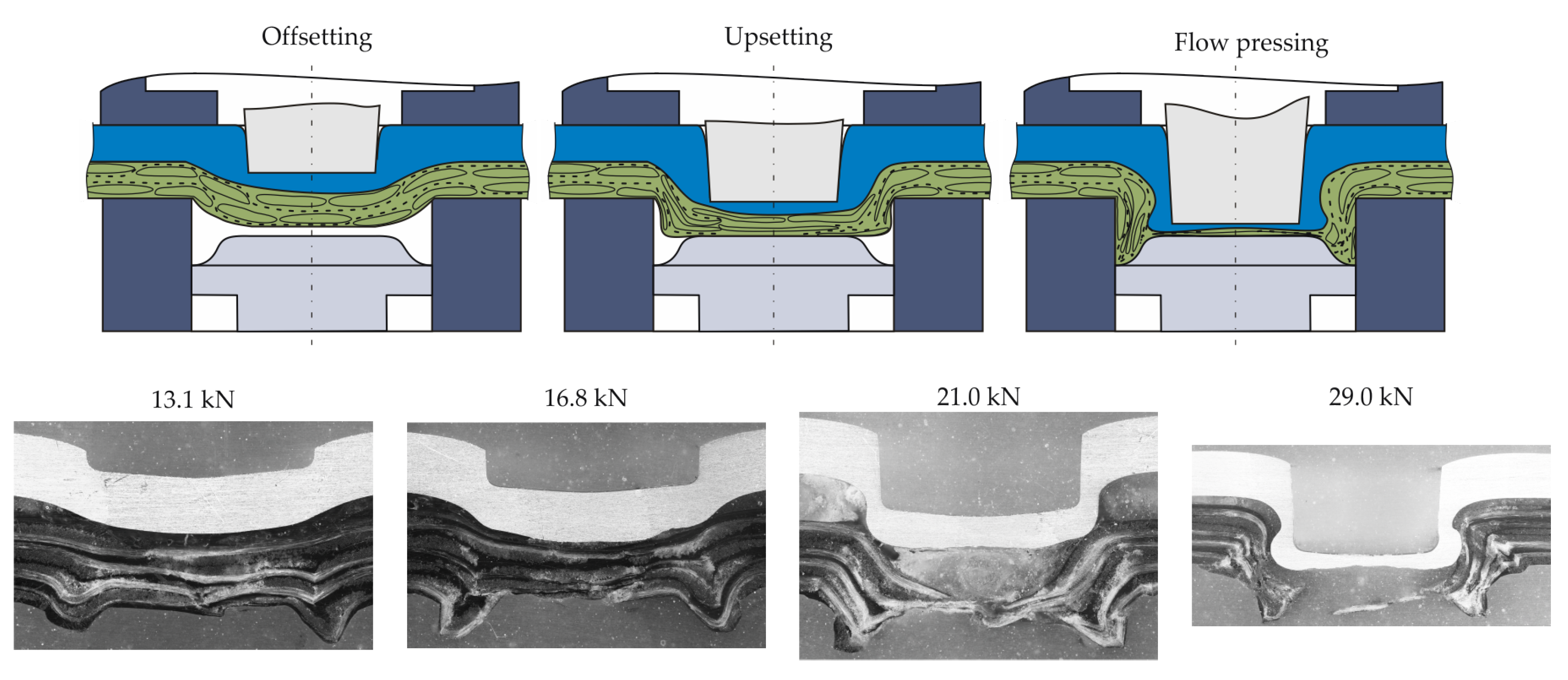

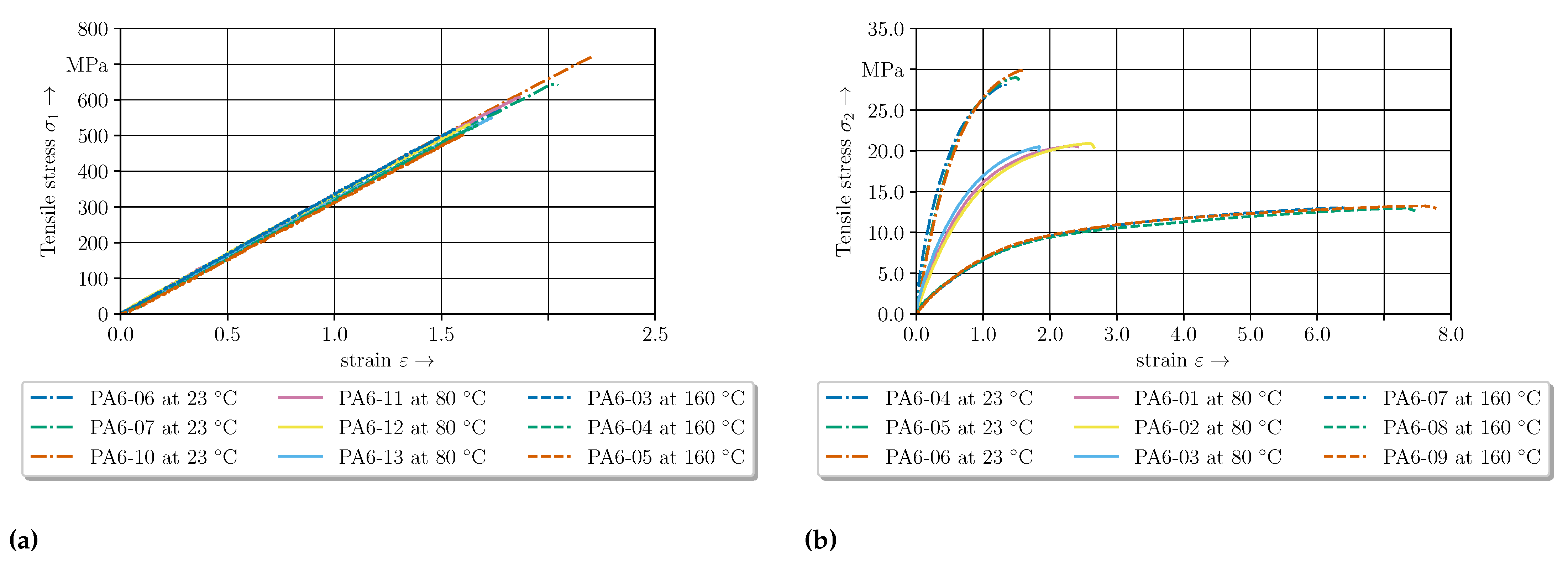
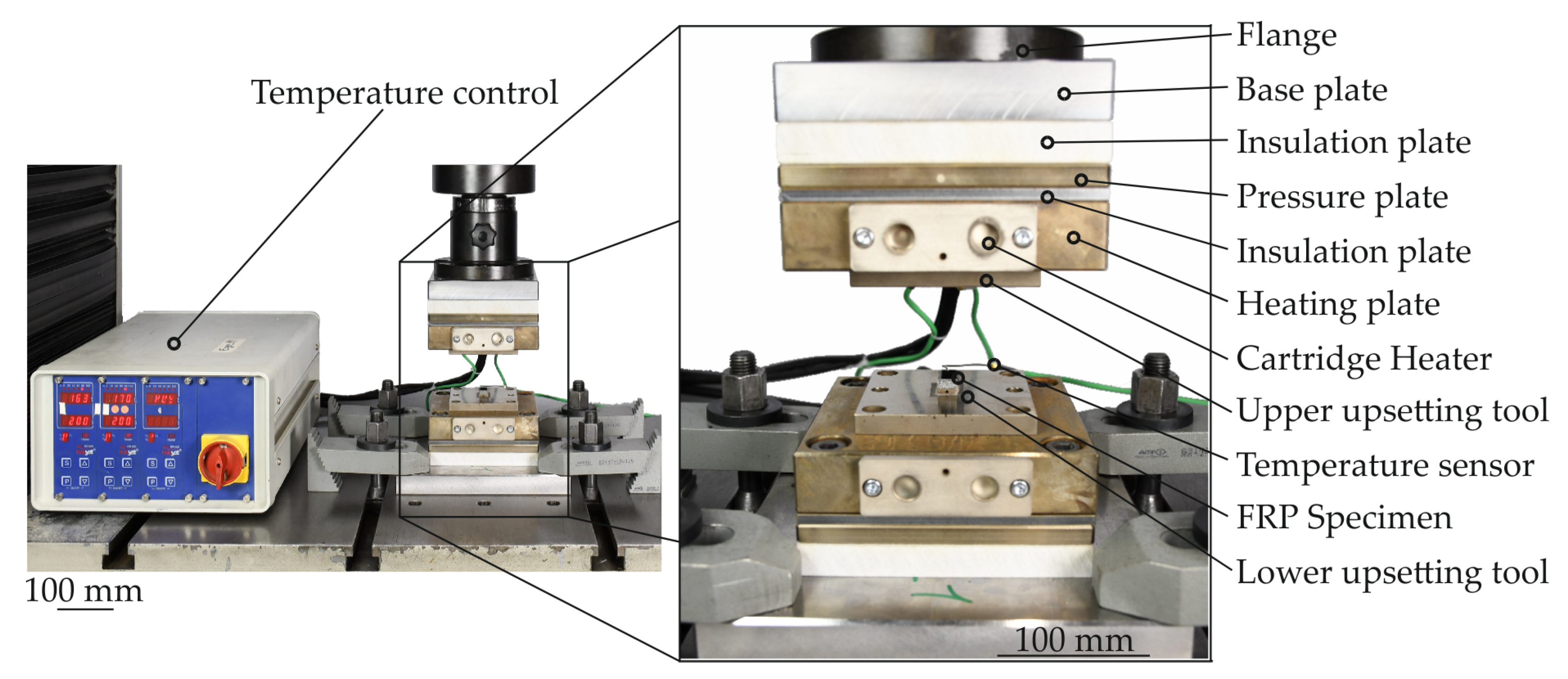
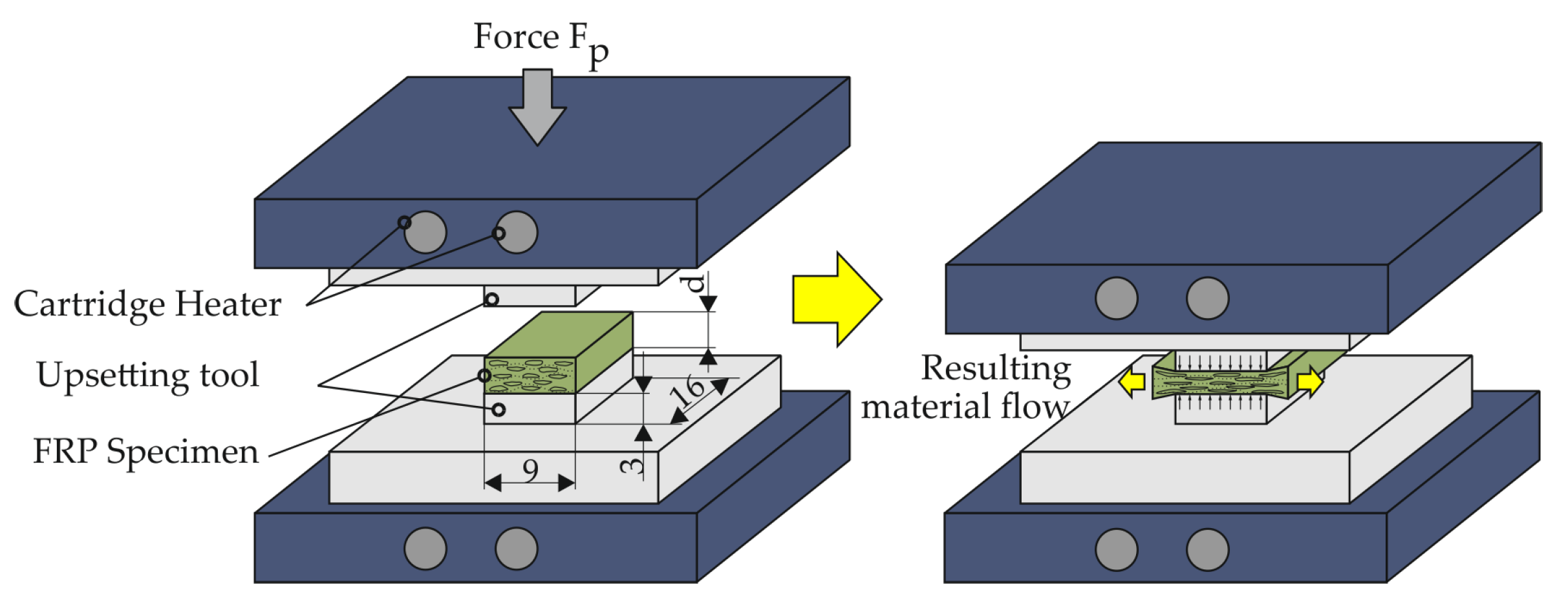
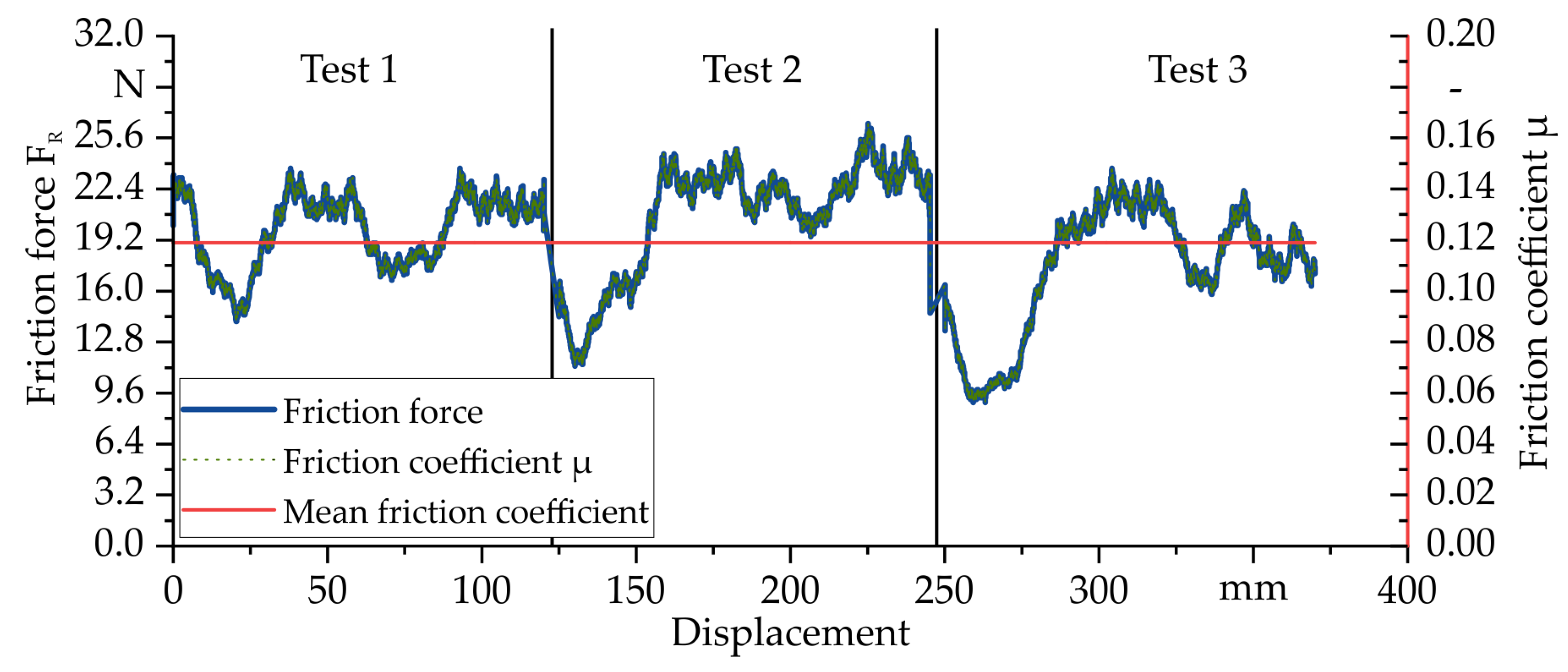
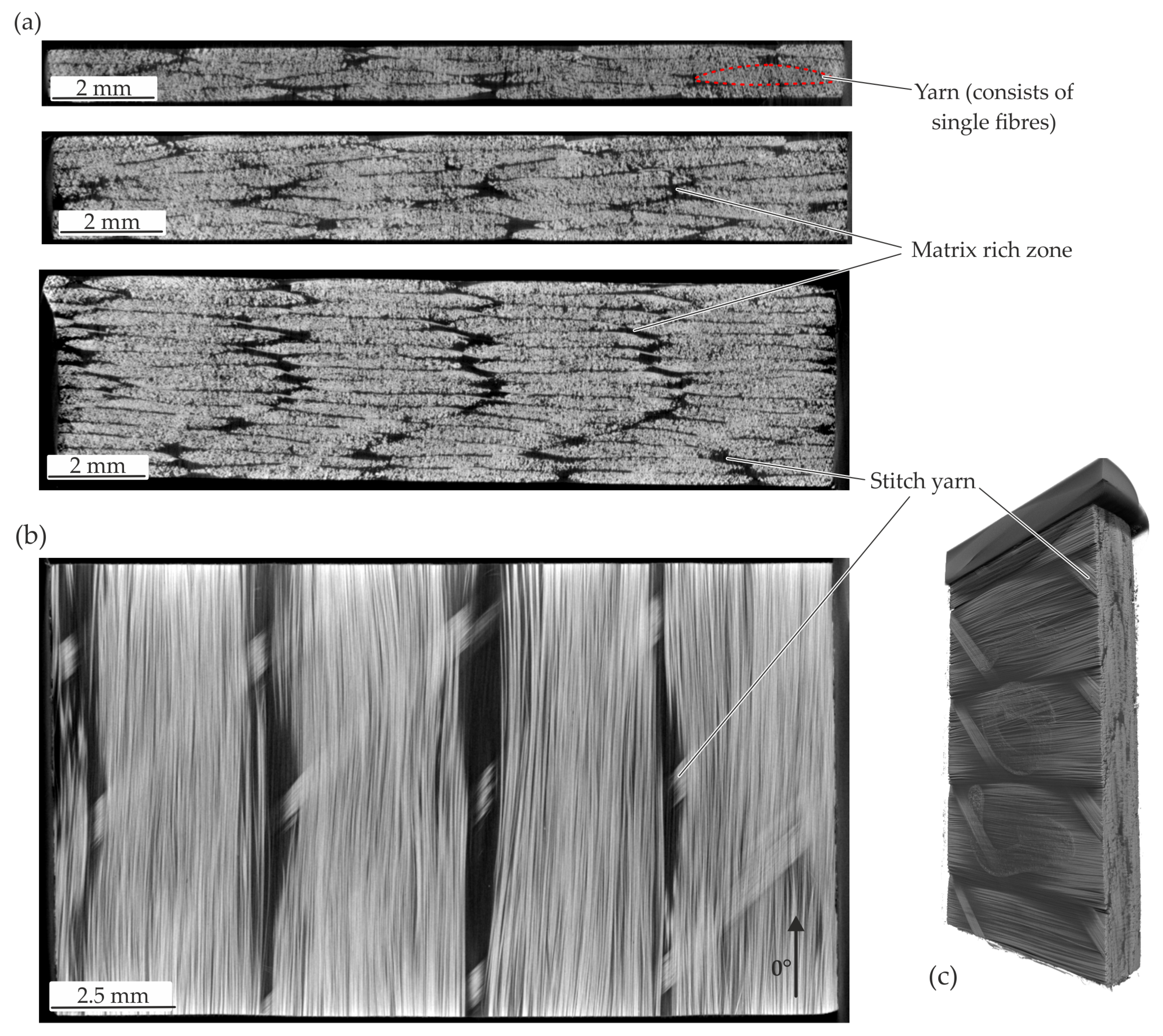
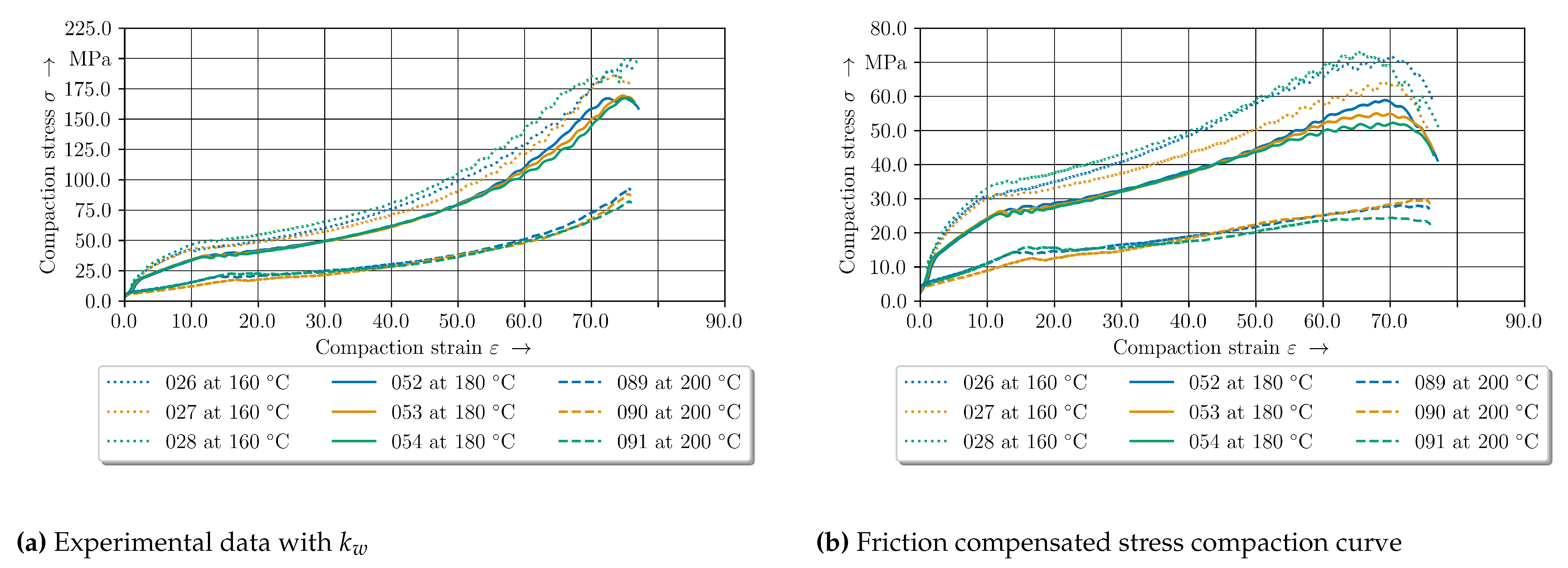
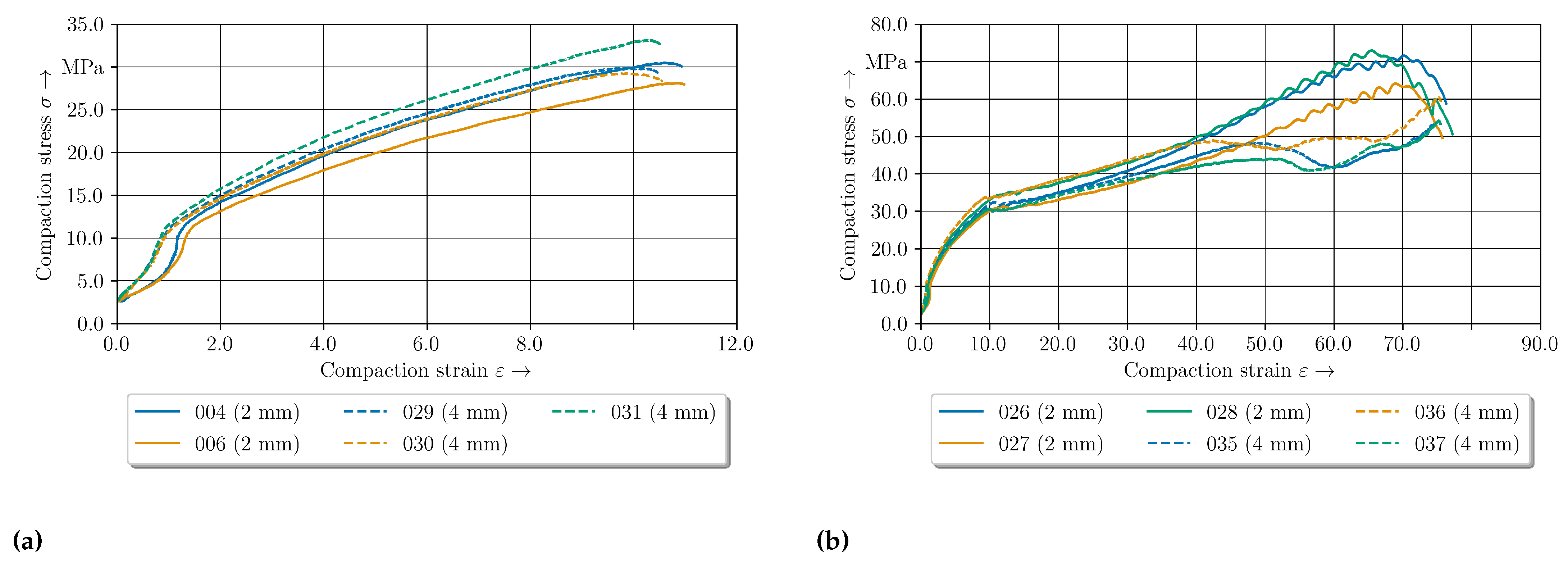

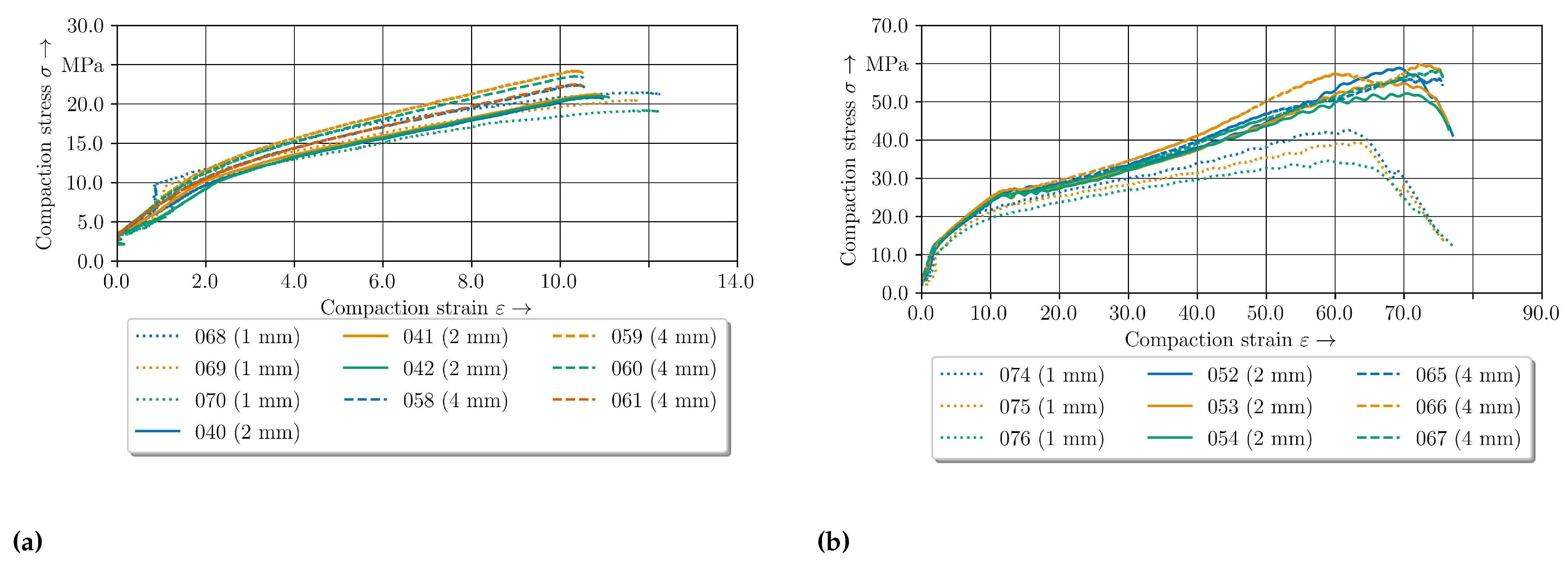
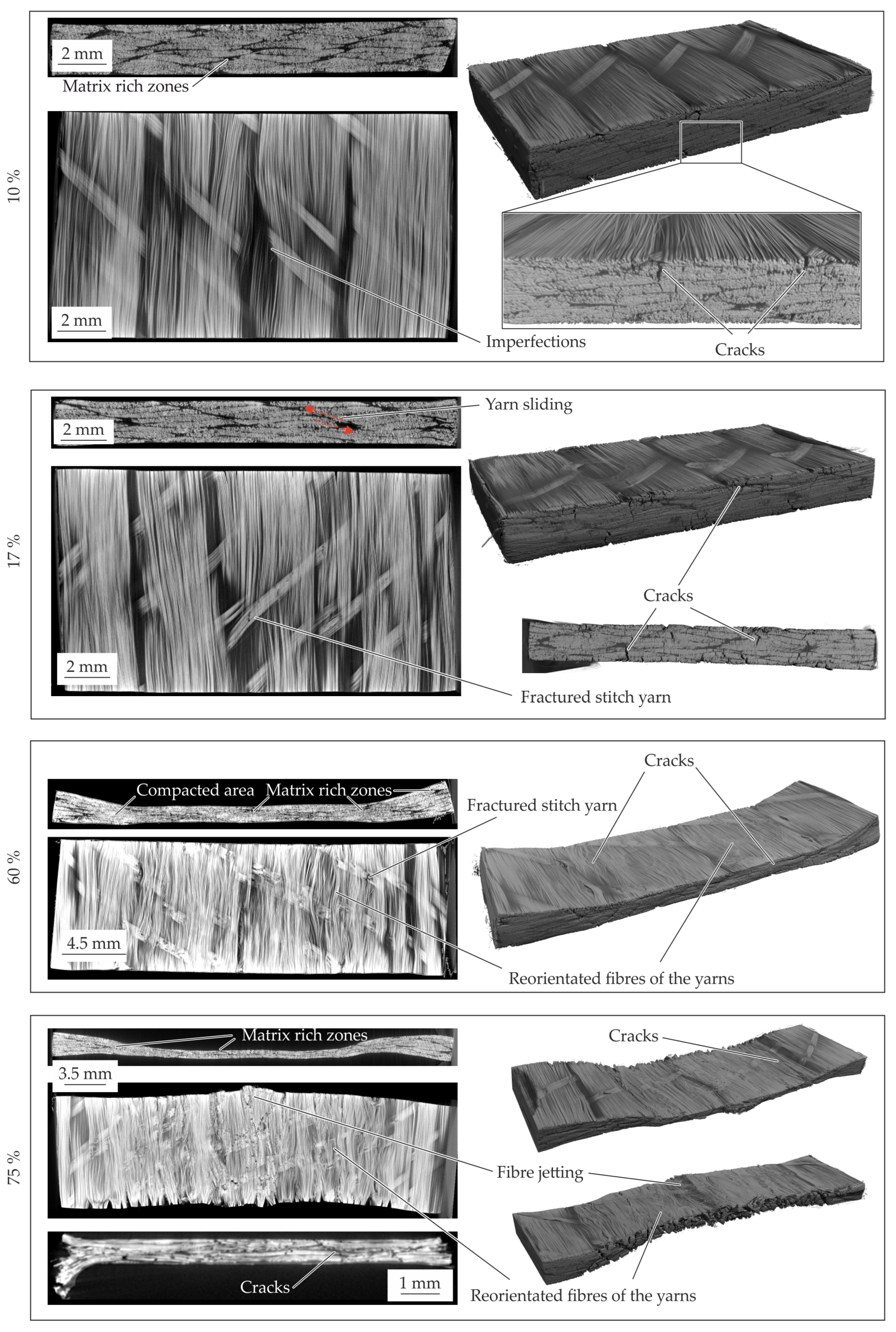
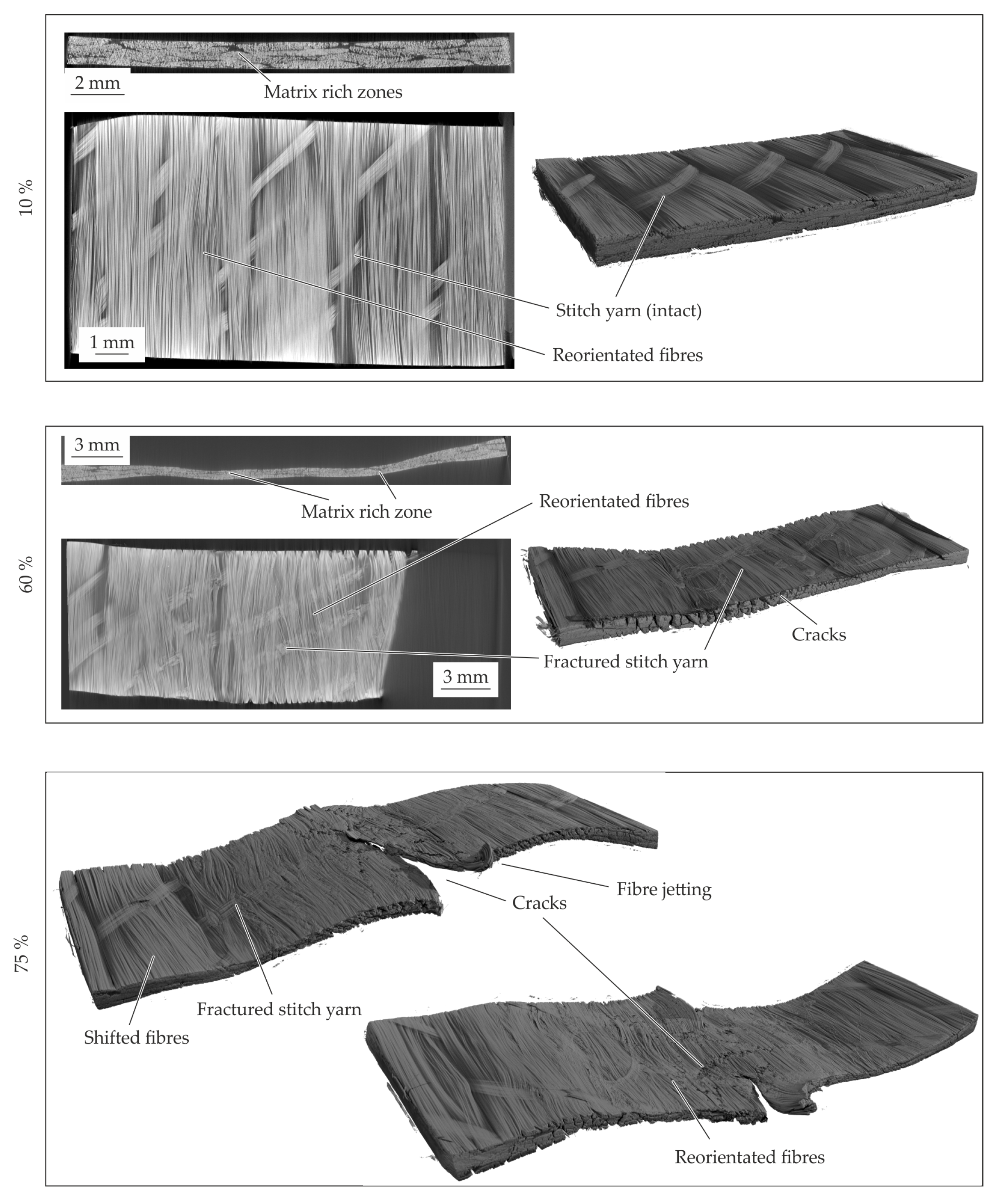
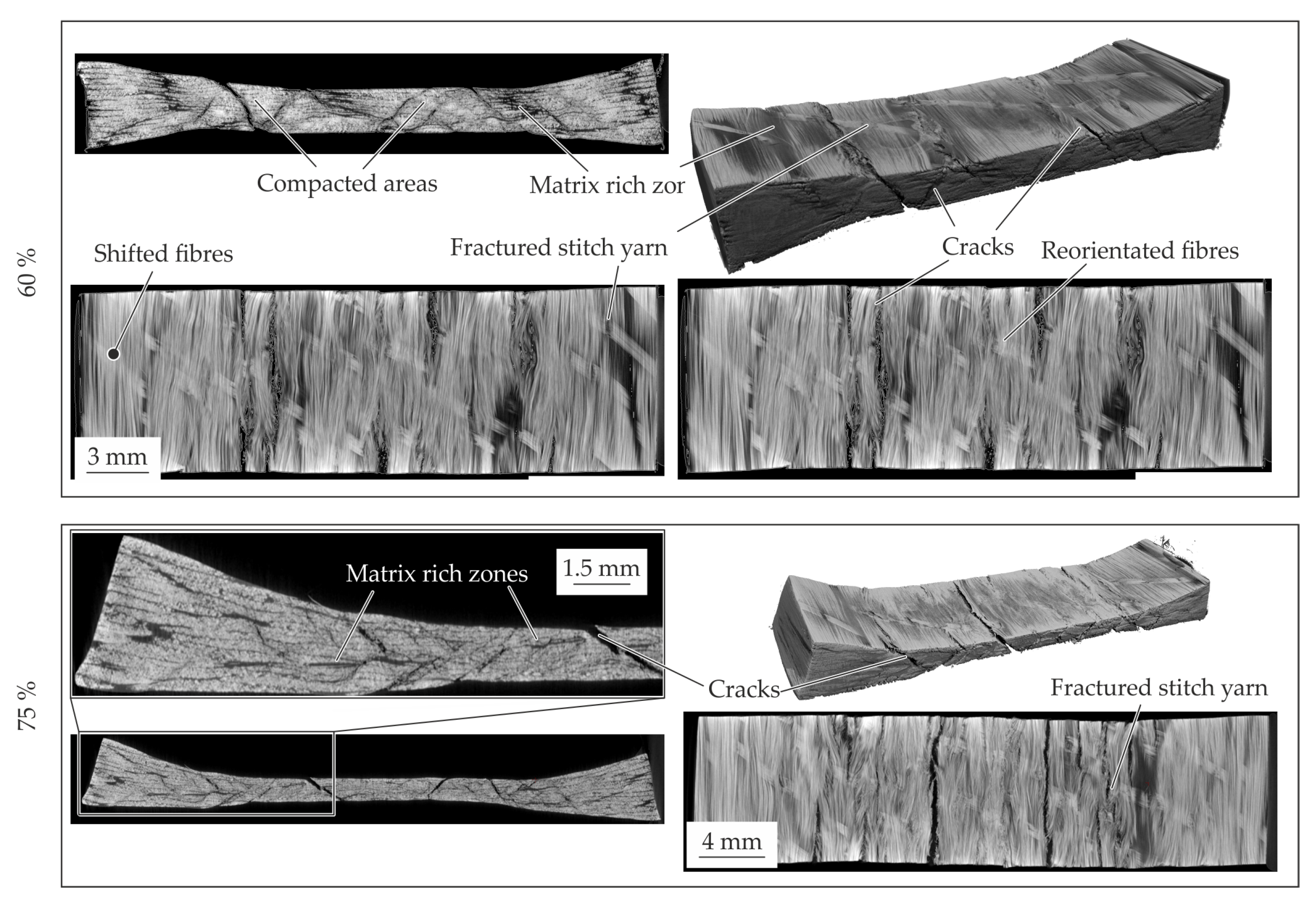
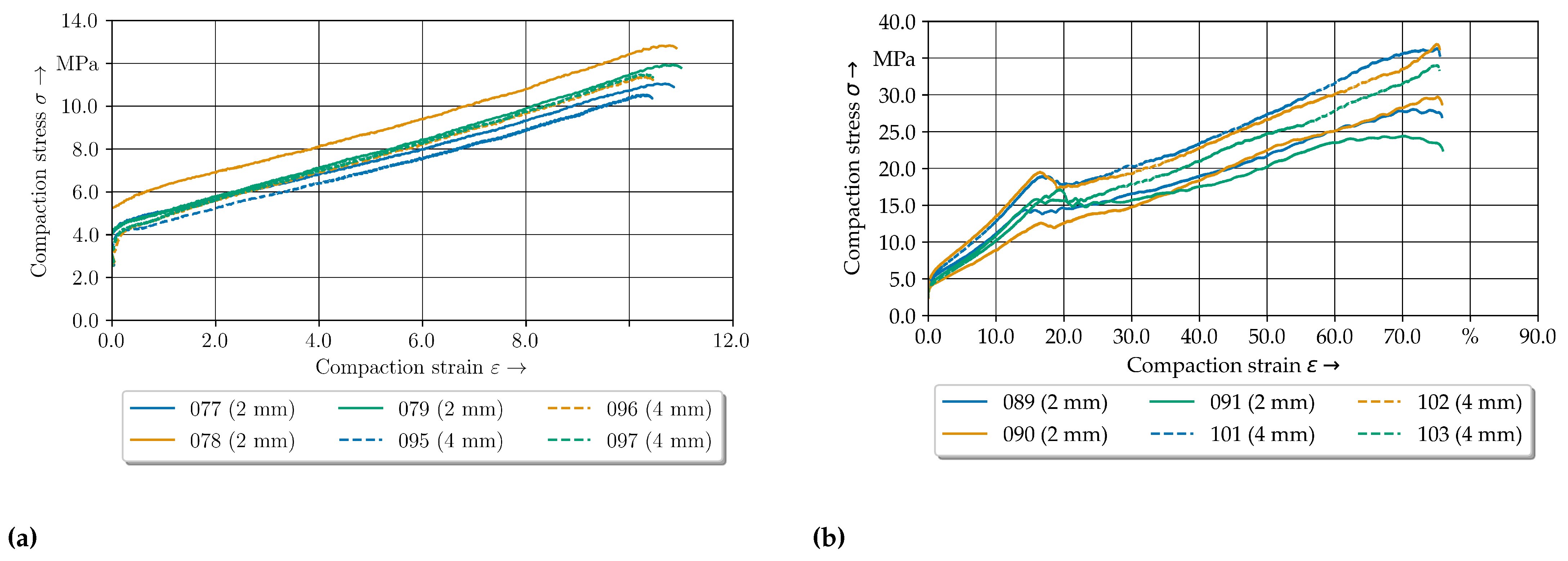

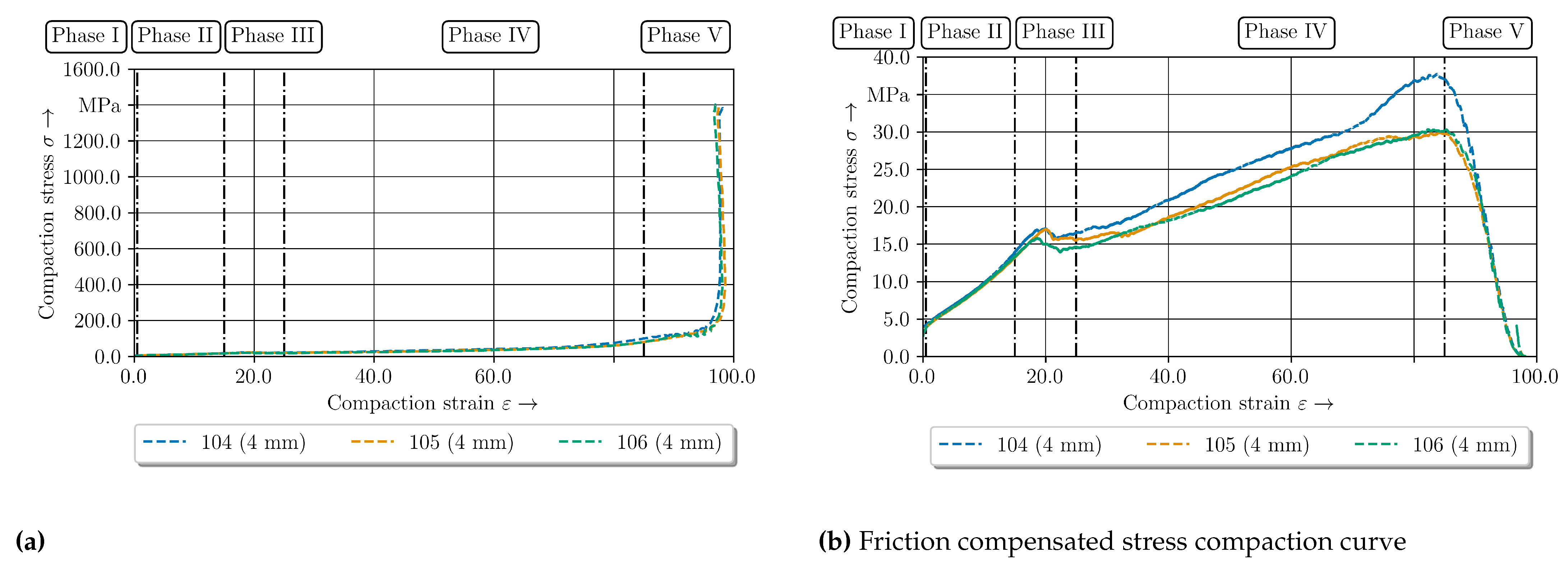
| TPC Sheet | |
|---|---|
| Material | GF/PA6 |
| Configuration | UD |
| Fibre volume content | 44% |
| Thickness d | 1 mm, 2 mm, 4 mm |
| Specimen area | 9 × 16 |
| d | T | Compaction Level in % | |||||
|---|---|---|---|---|---|---|---|
| in mm | in °C | 10 | 17 | 40 | 60 | 70 | 75 |
| 1 | 180 | x | x | x | |||
| 2 | 160 | x | x | x | x | x | |
| 180 | x | x | x | x | x | x | |
| 200 | x | x | x | x | x | ||
| 4 | 160 | x | x | x | x | ||
| 180 | x | x | x | x | |||
| 200 | x | x | x | ||||
| Parameter | Unit | Value |
|---|---|---|
| Acceleration voltage | 80 | |
| Tube current | 200 | |
| Exposure time | 1000 | |
| X-ray projections | 1440 (4 per 1°) | |
| Source object distance | 90 | |
| Source image distance | 1200 | |
| Voxel size | 15.0 | |
| Filter | 0.2 (copper) |
Publisher’s Note: MDPI stays neutral with regard to jurisdictional claims in published maps and institutional affiliations. |
© 2022 by the authors. Licensee MDPI, Basel, Switzerland. This article is an open access article distributed under the terms and conditions of the Creative Commons Attribution (CC BY) license (https://creativecommons.org/licenses/by/4.0/).
Share and Cite
Gröger, B.; Römisch, D.; Kraus, M.; Troschitz, J.; Füßel, R.; Merklein, M.; Gude, M. Warmforming Flow Pressing Characteristics of Continuous Fibre Reinforced Thermoplastic Composites. Polymers 2022, 14, 5039. https://doi.org/10.3390/polym14225039
Gröger B, Römisch D, Kraus M, Troschitz J, Füßel R, Merklein M, Gude M. Warmforming Flow Pressing Characteristics of Continuous Fibre Reinforced Thermoplastic Composites. Polymers. 2022; 14(22):5039. https://doi.org/10.3390/polym14225039
Chicago/Turabian StyleGröger, Benjamin, David Römisch, Martin Kraus, Juliane Troschitz, René Füßel, Marion Merklein, and Maik Gude. 2022. "Warmforming Flow Pressing Characteristics of Continuous Fibre Reinforced Thermoplastic Composites" Polymers 14, no. 22: 5039. https://doi.org/10.3390/polym14225039







